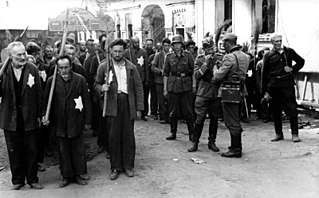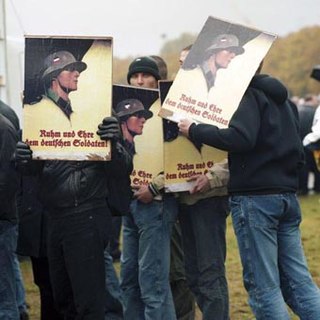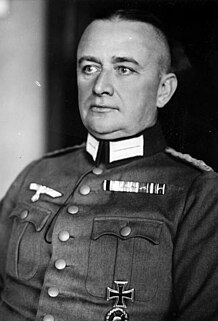
A body count is the total number of people killed in a particular event. In combat, a body count is often based on the number of confirmed kills, but occasionally only an estimate. Often used in reference to military combat, the term can also refer to any situation involving multiple killings, such as the actions of death squads or serial killers.

The German occupation of Byelorussia, now known as Belarus, started with Germany's invasion of the Soviet Union on 22 June 1941 and ended in August 1944 with the Soviet Operation Bagration. The western parts of the Byelorussian Soviet Socialist Republic became part of the Reichskommissariat Ostland in 1941, but in 1943 the German authorities allowed local collaborators to set up a client state, the Belarusian Central Rada, that lasted until the Soviets restablished control over the region. During the occupation, German actions led to about 1.6 million civilian deaths including 500,000 to 550,000 Jews in the Holocaust in Belarus.

The 286th Security Division was a rear-security division in the Wehrmacht during World War II. The unit was deployed in German-occupied areas of the Soviet Union, in the Army Group Centre Rear Area. It was responsible for large-scale war crimes and atrocities including the deaths of thousands of Soviet civilians.

Gustav Lombard was a high-ranking member in the SS during World War II. During the war, Lombard commanded 8th SS Cavalry Division Florian Geyer and the 31st SS Volunteer Grenadier Division. He was a recipient of the Knight's Cross of the Iron Cross of Nazi Germany for so-called "anti-partisan" operations around Kovel which involved killing of civilians and burning down villages.
Johann-Georg Richert was a German general during World War II. He commanded the 286th Security Division whose personnel committed numerous war crimes in occupied Belarus, in the Army Group Center Rear Area.
Ludwig Merker was a German general in the Wehrmacht during World War II. He was a recipient of the Knight's Cross of the Iron Cross of Nazi Germany.

The myth of the clean Wehrmacht is the negationist notion that the regular German armed forces were not involved in the Holocaust or other war crimes during World War II. The debunked myth, heavily promoted by German authors and military personnel after World War II, completely denies the culpability of the German military command in the planning and preparation of war crimes. Even where the perpetration of war crimes and the waging of an extermination campaign, particularly in the Soviet Union – where the Nazis viewed the population as "sub-humans" ruled by "Jewish Bolshevik" conspirators – has been acknowledged, they are ascribed to the "Party soldiers", the Schutzstaffel (SS), but not the regular German military.

The Wehrmacht: History, Myth, Reality is a 2002 book by German historian Wolfram Wette which discusses the Myth of the clean Wehrmacht. The original German-language book was translated into five languages; the English edition was published in 2007 by Harvard University Press. The book builds on Omer Bartov's 1985 study The Eastern Front, 1941–1945: German Troops and the Barbarisation of Warfare. The book received a positive reception.

The 201st Security Division, originally the 201st Security Brigade, was a German Army rear-area security division of World War II. The unit was deployed in German-occupied areas of the Soviet Union, and was responsible for large-scale war crimes and atrocities including the deaths of thousands of Soviet civilians. It was disbanded in January 1945

Max von Schenckendorff was a general in the Wehrmacht of Nazi Germany during World War II. He was the commander of Army Group Rear Area behind Army Group Centre from March 1941 until his death. He is best known for organising the Mogilev conference, in which Wehrmacht and SS officers discussed "bandit fighting" tactics, meaning the mass murder of Jews and other real or perceived enemies. The conference resulted in an intensification of the genocide that was already taking place in Army Group Centre Rear Area.
The 221st Security Division was a rear-area security division in the Wehrmacht during World War II. Commanded by General Johann Pflugbeil, the unit was deployed in German-occupied areas of the Soviet Union, in the Army Group Centre Rear Area, for security and Bandenbekämpfung ("anti-bandit") duties. It was responsible for large-scale war crimes and atrocities including the deaths of thousands of Soviet civilians.
Army Group Rear Area Command was an area of military jurisdiction behind each of the three Wehrmacht army groups from 1941, the German invasion of the Soviet Union in Operation Barbarossa, through 1944 when the pre-war territories of the Soviet Union had been liberated. The areas were sites of mass murder during the Holocaust and other crimes against humanity targeting the civilian population.
The 203rd Security Division, was a rear-security division in the Wehrmacht of Nazi Germany. The unit was deployed in German-occupied areas of the Soviet Union, in the Army Group Centre Rear Area and was responsible for large-scale war crimes and atrocities.
The Mogilev Conference was a September 1941 Wehrmacht training event aimed at improving security in the rear of Army Group Centre during Operation Barbarossa, the German invasion of the Soviet Union. The event was organised by General Max von Schenckendorff, commander of Army Group Centre Rear Area, in cooperation with the officials of the security and intelligence services of Nazi Germany—SS and the Sicherheitsdienst —operating in the same area. Ostensibly an "anti-partisan" training conference, the event marked an escalation of violence against Jews and other civilians in the areas under Schenckendorff's command.
Army Group South Rear Area was one of the three Army Group Rear Area Commands, established during the 1941 German invasion of the Soviet Union. Commanded by General Karl von Roques, it was an area of military jurisdiction behind Wehrmacht's Army Group South.
The Police Regiment North was a police formation under the command of the SS of Nazi Germany. During Operation Barbarossa, it was deployed in German-occupied areas of the Soviet Union, in the Army Group North Rear Area.

Army Group Centre Rear Area was one of the three Army Group Rear Area Commands, established during the 1941 German invasion of the Soviet Union. Initially commanded by General Max von Schenckendorff, it was an area of military jurisdiction behind Wehrmacht's Army Group Centre.

Franz von Roques was a German general during World War II. He was the commander of Army Group North Rear Area behind Army Group North from March 1941 to April 1943.

Erich Friderici was a German general during World War II. He was the commander of Army Group South Rear Area behind Army Group South from 27 October 1941 to 9 January 1942, while the original commander, Karl von Roques, was on medical leave.
Waitman Wade Beorn is a historian who studies the Holocaust in Eastern Europe. He is currently a Senior Lecturer in History at Northumbria University in Newcastle, UK. Previously, he served as the Louis and Frances Blumkin Professor of Holocaust and Genocide Studies at the University of Nebraska-Omaha. From 2015-2016, he was the executive director of the Virginia Holocaust Museum in Richmond, Va.











